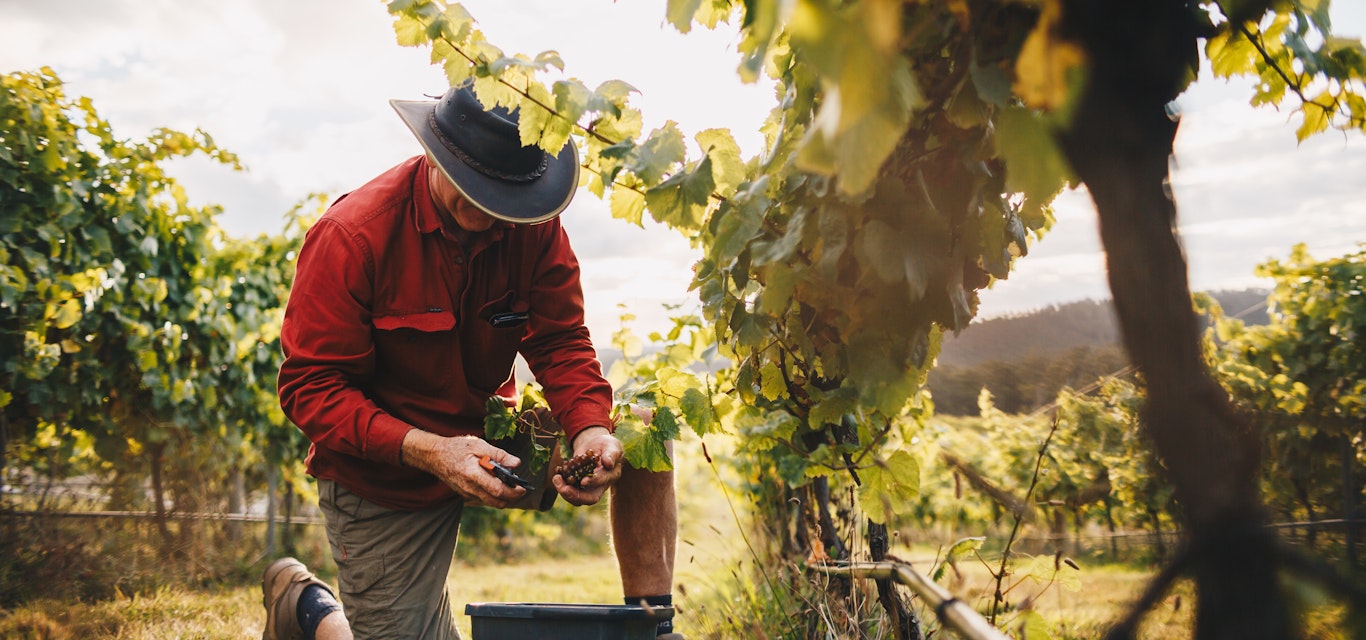100 years of Tassie food
The Tasmania of today is unrecognisable from the Tasmania of 100 years ago, epitomised by nothing more than its food. Andrew Bain charts the rise of gourmet Tasmania.
There was a time, not so long ago, when Tasmania was merely the Apple Isle. Today, those apples are just as likely to be bottled as cider, complementing a feast of Tassie cheese, seafood, wagyu, truffles, cherries and berries.
Local food, wine and spirits have rightly been lauded in recent years, but the seeds of this acclaim were planted long ago – it’s literally taken decades for Tasmanian produce to become an ‘overnight success’.
Almost 50 years ago, when Dr Andrew Pirie was planting one of the state’s first vineyards in Piper’s Brook in 1974, even the Tamar Valley was almost devoid of wineries, with state government policy actively discouraging the industry.
“The official register at that time was about 6ha of vineyards in Tasmania, made up of a lot of little backyard parcels,” Dr Pirie says. “The government had read some research, which was wrong, that suggested Tasmania was too cold for viticulture.”
A year later, in an attempt to convince the government to change that policy, Dr Pirie wrote an article in the Australian Financial Review predicting a day when Tasmania would have a thriving, well-paired food and wine industry.
“The possibility of Tasmanian salmon-trout with a delicate wood-aged chardonnay, local rock lobster and a steely, dry riesling or some of that fine local beef washed down with draughts of elegant cabernet – it’s enough to make a tourist go down there even in winter,” he wrote.
Art and produce
What Dr Pirie was describing was the Tasmania of today, though it would be a while coming. Even when Rodney Dunn shifted to Tasmania to start The Agrarian Kitchen Cooking School in 2008, the search for fine local produce was almost mythical.
“It existed, but it was very difficult to find,” Rodney says. “It was like, ‘go down this road at this time of year and in this gate, and this guy called Jim will have great moorpark apricots’. At that stage, it was all very small, but we’ve seen it swell and swell and swell.”
It was a time when Tasmania had yet to amass its abundance of top restaurants. Places such as Lebrina and Stillwater, inside its 19th-century flour mill at the mouth of Cataract Gorge, existed, and the likes of Hobart’s Garagistes and Sweet Envy would open within a couple of years, but the dining revolution really began apace when Mona opened its artistic doors in 2011.
“What Mona did was bring people who were savvy and interested in experiencing food and wine on that kind of level,” says Rodney. “If we didn’t have Mona, our restaurant would look a lot different. People need more than a single reason to go somewhere – you very rarely go to a place for just one restaurant. Having multiple things to do when they come down gives them a reason.”
Today, the Agrarian Kitchen, with its cooking school and celebrated restaurant, and Dr Pirie’s Apogee winery are no longer gastronomic outliers. Where once visitors came to Tasmania predominantly to bushwalk, lap the island in a van, or poke about convict relics, today they’re just as likely to be here for the produce and pours.
An almost inexhaustible list of ingredients – oysters, berries, cherries, apples, cheese, olives, craft beer, hazelnuts, honey, kimchi, garlic, wasabi – is being coaxed from the soil and seas, and there are now more than 70 distilleries sprinkled around the state, a far cry from even 30 years ago when a ban on distilling had to be overturned to allow Bill Lark to start the state’s first distillery.
“If you’d said to me 30 years ago that there’d be more than 70 distilleries in Tasmania, I’d have said you’re mad,” says Bill. “I’ve been excited and willing for it to happen, but I could never have dreamed it would have happened like this.”
There are restaurants as fine as any in the country (five Tasmanian restaurants made Gourmet Traveller’s list of Australia’s top 82 restaurants last year) and pubs such as Hobart’s Tom McHugo’s and the Clarendon Arms in Evandale have evolved into champions of local produce. Others like Queenstown’s Empire Hotel and Pyengana’s Pub in the Paddock add history and quirks to the menu.
State on a plate
Among the state’s pioneers of produce, there’s immense satisfaction and pride in this overdue twist in the tale of Tasmanian food. When Anna Terry’s father, Tim, pulled Australia’s first truffles from the Red Hills earth in 1999, few people knew what to make of the fungi, forcing him to ship the entire harvest off the island. Today, the black gold from Tasmanian Truffles, run now by Anna and her brother Henry, is found in restaurants across the state, typically among a range of ingredients from other local farms.
“Often I’ll see our truffles on the menu and I know the farmer that the lamb’s come from, and where the spuds are being grown, and so there’s that sense of community,” she says. “It’s quite nice when you see not just our food together on the plate, but you really see something of a community and a bunch of mates on a plate.
“It’s been pretty epic to be a part of that.”
